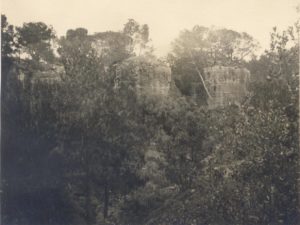R797 – La Carrière de Bibémus, vers 1895 (FWN306)
Pavel Machotka
(Cliquer sur les images pour les agrandir)
Of all the peculiar formations created at Bibémus by quarrying, the one Cézanne chose as a subject for La carrière de Bibémus is the most unpromising: too massive in the center, too light on its feet, and too cluttered on top. Loran was able photograph it in the late 1920s[1]—it has since disappeared—and from the priceless photograph we learn that Cézanne was aware of the problem and changed two aspects of the composition. He narrowed the middle bulge, lightening it, and tilted everything in the upper half of the composition to the right, balancing the many lines that lean to the left. Among landscapes this is the only change of this extent that I know, and in his customary range of adjustments seems quire radical; but if we compare the photograph with the painting, all doubts disappear. The painting, if a bit relentless and stubborn, is a dynamic and vigorous construction, audacious in the risks it takes, and surprising in the balance that it achieves. (Not to omit pointing out the delicate grey touches which lighten what would be a relentless brown-ochre.)
Source: Machotka, Landscape into Art.
[1] In Erle Loran, Cézanne’s Composition, 1944, pp. 60-65; also reproduced in Machotka, Landscape into Art.
A titre de curiosité, on peut comparer avec un thème identique chez Corot :





